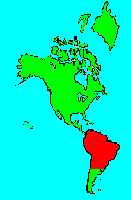SPECIES INFO
Grey-winged trumpeter (Psophia crepitans) is found near or north of the Equator in South America. This is found from northern Peru and Ecuador east to the Guyanas and the mouth of the Amazon. This 20 inch bird is generally brown with pale legs. The wings are gray.
There are two subspecies. The nominate subspecies is found from southern Colombia to the Guyanas and northern Brazil. The subspecies napensis is found from southern Colombia south to NE Peru and northwestern Brazil. BR>
In Chambers they noted this bird could be easily domesticated. It was able to run with the hounds. In older texts this life form was sometimes called the gold breasted trumpeter.The trumpeter genus (psophia) is found on the mainland of South America. Examples are found primarily in the Amazon Valley from the lowlands near the mouth to the edges of the Andes. These birds have a total length of about 20 inches. These are primarily a terrestrial species with a tendency to form groups.
Currently three species are recognized. However, in 1888 only two were recognized.
The trumpeters (Psophiidae) are a small family of only three species native to the mainland of South America. There is a single genus Psophia in the family. These birds have short tails, long legs and necks, and heavy chicken like beaks. These birds travel in flocks of over one hundred examples. They are able swimmers. Several Indian tribes keep these birds along with chickens as a food staple.
Cranes and Rails (Order Gruiformes) are a worldwide group of 199 species, some of which have recently become extinct. They are medium to large in size and usually associated with water. Several species have long legs and/or long necks.
Aves contains about 8,650 different species of living birds known to science. Each year about one new species is discovered in some remote rain forest or remote island. In addition, scientists have been raising many subspecies to full species status which may raise the species count to 10,000. Birdlife recognizes 10,027 species as of 2011.
However, each year about one species goes extinct. The rate of extinction is increasing, and the rate of new discovery is decreasing, so that the number of bird species will soon begin to decline rapidly. Although different taxonomists would organize the birds differently, there are approximately twenty-seven orders of birds. These orders are broken down into about one hundred and fifty-five different families.
Recent research of the genetic structure of some of the shore birds and owls would indicate that the present organization of orders and families should have some modification.
The birds are a worldwide group of animals that are characterized by having the front limbs modified into wings that are used for flying. Perhaps the most unique feature of the birds is the feathers. These feathers are made up of a central support called a quill and a series of small filaments that are hooked together as barbs.
For many years it was believed that Archaeopteryx discovered in Bavaria was the oldest bird from about 150 million years ago. However, in l986, Sankar Chattterjee, a Texas paleontologist, reportedly discovered a bird in the genus Protoavis that lived about 225 million years ago.
When this project was begun in 1978, we used Austin & Singer for bird taxonomy. Since then, we have adopted many changes, but have kept some older concepts that are still found widely in the literature. Recently, we have used Clements and Howard & Moore. Very recently, we have used Monroe and Sibley for the higher taxonomy of the perching birds.
Backboned Animals (Phylum Chordata) are the most advanced group of animals on earth. These animals are characterized by having a spinal cord or backbone. Most members have a clearly defined brain that controls the organism through a spinal cord. Fish, amphibians, reptiles, birds, and mammals are in this phylum.
Currently, some taxonomists believe that the fish should be divided into two groups (sharks and regular fishes) and that there are some other primitive groups in the phylum such as hagfish or lampreys.
Animal Kingdom contains numerous organisms that feed on other animals or plants. Included in the animal kingdom are the lower marine invertebrates such as sponges and corals, the jointed legged animals such as insects and spiders, and the backboned animals such as fish, amphibians, reptiles, birds, and mammals.


